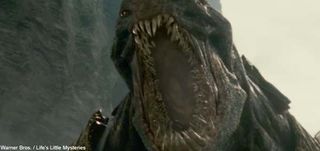What Is a Kraken?

In the new film "Clash of the Titans," Zeus, king of the gods, barks the order to "Release the Kraken!" The term is becoming a cult-like catchphrase.
But what is a Kraken, and why would anyone want to release it?
In the film, the Kraken is a massive multi-limbed monster that roars menacingly and can destroy cities with a sweep of its arms. It seems to be the ultimate threat, Zeus's nuclear option to teach unruly and disrespectful humans a lesson they would never forget.
Though the filmmakers took plenty of artistic license in depicting the Kraken, they did not have to start from scratch. In fact the Kraken was first described in a manuscript about a thousand years ago; Scandinavian mythology depicted the Kraken as so large that its body appeared as several small islands. Unsuspecting sailors would be lured toward land, until the "islands" erupted out of the water into a terrifying tangle of tentacles that easily pulled ships to their watery doom.
Centuries ago when the line between legendary beast and zoological reality was blurry, the Kraken was only one of several fantastic animals whose existence was debated (including dragons and sea monsters). In 1752 Scandinavian bishop Eric Ludvigsen Pontopiddan published a (presumably non-fiction) book titled Natural History of Norway, in which he included a section on sea monsters. He described the monstrous Kraken as "round, flat, and full of arms."
About a century later, science finally attached a zoological name to the Kraken. By the late 1800s scientists had enough reliable sightings and evidence (including bodies washed up on Newfoundland beaches) to officially name and identify the beast. Stories of the Kraken were likely inspired by a real marine monster: the Giant squid (Architeuthis).
- Dangers in the Deep: 10 Scariest Sea Creatures
- Rumor or Reality: The Creatures of Cryptozoology
- Our 10 Favorite Monsters
Sign up for the Live Science daily newsletter now
Get the world’s most fascinating discoveries delivered straight to your inbox.

